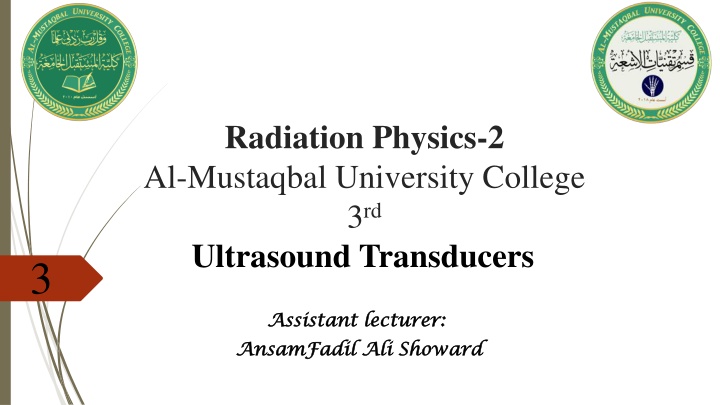
Ultrasound Imaging Systems and Transducers Overview
Explore the basics of ultrasound imaging systems, including the functional components and the role of transducers in converting electrical to mechanical energy. Learn about piezoelectric crystals in ultrasound probes and their significance in emitting and receiving ultrasound waves efficiently.
Download Presentation

Please find below an Image/Link to download the presentation.
The content on the website is provided AS IS for your information and personal use only. It may not be sold, licensed, or shared on other websites without obtaining consent from the author. If you encounter any issues during the download, it is possible that the publisher has removed the file from their server.
You are allowed to download the files provided on this website for personal or commercial use, subject to the condition that they are used lawfully. All files are the property of their respective owners.
The content on the website is provided AS IS for your information and personal use only. It may not be sold, licensed, or shared on other websites without obtaining consent from the author.
E N D
Presentation Transcript
Radiation Physics-2 Al-Mustaqbal University College 3rd Ultrasound Transducers 3 Assistant lecturer: Assistant lecturer: AnsamFadil AnsamFadil Ali Ali Showard Showard
Note:Ultrasound Imaging Systems The basic functional components of an ultrasound imaging system are shown below. Figure 1: The principal functional components of an ultrasound imaging system Therefore, the boxes in the illustration above represent functions performed by the computer and other electronic circuits and not individual physical components
Ultrasound Transducers In general, a transducer is a device that converts energy from one form to another, in the case of Ultrasound transducers; the conversion is from electrical to mechanical energy (or vice versa). Ultrasonic Transducer Structures Transducers for ultrasound imaging consist of one or more piezoelectric crystals or elements. imaging is often performed with multiple-element arrays of piezoelectric crystals. Piezoelectric materials change in size when a voltage is applied across them and, conversely, generate a voltage in response to an applied pressure. Modern medical ultrasound probes usually contain the material lead zirconate titanate (PZT) A piezoelectric transducer comprises a "crystal" sandwiched between two metal plates. When a sound wave strikes one or both of the plates, the plates vibrate. The crystal picks up this vibration, which it translates into a weak AC voltage. Therefore, an AC voltage arises between the two metal plates, with a waveform similar to that of the sound waves.
Figure 2: Basic design of (a) probe contains hundreds of transducers (b) single-element transducer.
Piezoelectric transducers are common in ultrasonic applications, such as intrusion detectors and alarms. The basic design of a plain transducer is shown in figure 2. Figure 3: The transducer (or probe) is containing multiple piezoelectric crystals
The transducer (or probe) is containing multiple piezoelectric crystals, which are interconnected electronically and vibrating in response to the applied voltage (see figure3). The crystal is cut into a slice with a thickness equal to half a wavelength of the desired ultrasound frequency, why?, as this thickness ensures most of the energy is emitted at the fundamental frequency. Generally, the thickness of thin discs (usually 0.1 1 mm) determines the ultrasound frequency. When not emitting a pulse (as much as 99% of the time), the same piezoelectric crystal can act as a receiver that is the transducer can act as both a transmitter and a receiver
Types of Ultrasound Transducers The essential element of each ultrasound transducer is a piezoelectric crystal, serving two major functions: (1) producing ultrasound pulses and (2) receiving or detecting the returning echoes The ultrasound transducers differ in construction according to: piezoelectric crystal arrangement aperture (footprint), operating frequency (which is directly related to the penetration depth)
There are three types of transducers that most often used in the critical ultrasound imaging: Linear, Sector and Convex (standard or micro-convex) as shown in figure 5 Figure 5: Three types of transducers are most often used in the critical ultrasound imaging.
Linear Transducer Linear transducers are used primarily for small parts requiring high resolution and typically involve shallow depths. To achieve high resolution, higher frequencies are typically required. Since produce a rectangular image the elements are arranged in a linear fashion. piezoelectric crystal arrangement: linear footprint size: usually big (small for the hockey transducers) operating frequency (bandwidth): 3-12 MHz (usually 5-7.5 MHz) ultrasound beam shape: rectangular use: ultrasound of the superficial structures, e.g. obstetrics ultrasound, breast or thyroid ultrasound, vascular ultrasound
Sector Transducer To broaden the field of view, sector transducers are used. These transducers have a small footprint and are good for cardio applications due to small rib spacing. piezoelectric crystal arrangement: phased-array (most commonly used) footprint size: small operating frequency (bandwidth): 1-5 MHz (usually 3.5-5 MHz) ultrasound beam shape: sector, almost triangular use: small acoustic windows, mainly echocardiography, gynecological ultrasound, upper body ultrasound
Convex Transducer For abdominal viewing, curved transducers are typically used because of resolution and penetration benefits. They allow for the maximum field of view and depth because of their Linear Sector Convex large aperture. Note that any type of transducer can be phase arrayed to produce a beam of sound that can be steered and focused by the ultrasound controller. piezoelectric crystal arrangement: curvilinear, along the aperture footprint size: big (small for the micro-convex transducers) operating frequency (bandwidth): 1-5 MHz (usually 3.5-5 MHz) ultrasound beam shape: sector; the ultrasound beam shape and size vary with distance from the transducer, that causes the lack of lateral resolution at greater depths use: useful in all ultrasound types except echocardiography, typically abdominal, pelvic and lung (micro-convex transducer) ultrasound














